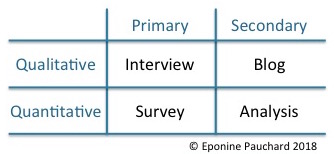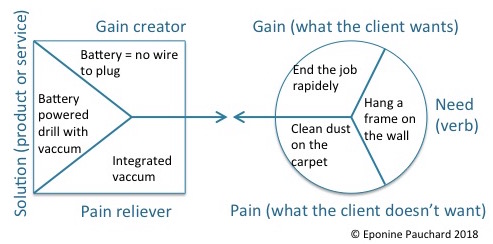We will always find a problem to fit with your brilliant solution. Unfortunately, this approach leads to random success. For your solution to be viable, it must address a problem.
In this article I will explain how to define a value proposition, then how to use a design thinking tool to make sure you meet the needs of your customers.

Why constrain yourself when you can create solutions?
Everyone has good ideas, from the simple to the revolutionary. But first, ask yourself what your customers’ needs are and then determine the best way to meet them. This approach may seem less exciting. Indeed, creating and finding great ideas, letting your mind wander freely is very stimulating. Many see the use of a more structured, customer-centric approach as a constraint that will limit their creativity. It is the opposite. The best ideas and solutions come from constrained environments, with a lack of resources forcing truly innovative solutions.
What is the value proposition?
The main constraint that I suggest you add in your product, service or solution creation process is to meet a customer need.
The value proposition is to align the client’s need with the service / product offered. And not the other way around: we have to find solutions to our problems. So know them. It sounds simple, but do not forget that the needs of customers are like the water of a flowing river: changing.
Once this is understood, we can focus on the problems we are trying to answer. We have to start from the client and the problem he is trying to solve or from the action he seeks to accomplish.
Identify client’s need(s)
Let’s start by separating the function from the object. For example, your customer does not need a drill, she needs to drill a hole to hang a frame. The drill is the answer to her need. The customer buys your product or service for the purpose of performing an action, functional or emotional. She expects a result: drill a hole safely, without messing, quickly, without noise, … Her objective is not the hole, but to see the picture hanging on the wall. You must speak with your customers to understand the need and design the product or service that will respond.
To assess the needs of your customers, you can use different ways. Some are qualitative, others quantitative. The search you perform yourself is the primary research. When you use other people’s data, it’s secondary research.

To obtain quantitative data, i.e. with numbers, you can conduct a survey (primary research) or use analyses conducted by others (secondary research). This data will help you prioritize, quantify and rationalize the other part of your research: the qualitative data. Based on interviews, reading blogs or articles, this data will bring a different perspective and often more in line with emotional needs.
Your goal is to obtain your client’s functional and emotional needs:
- Mariana needs to drill a hole in the wall to display her family photo and feel connected.
- Chûyen needs to deliver the maximum number of customers in the minimum time, to increase his income and improve his financial security.
- Moussa wants a child care solution for his children, so they can socialize with other children.
- Satomi needs a software to fill her taxes, because she wants to be reassured to declare her income correctly.
As a result of your analysis, you should have several segments or personas with the same functional need, but different emotional needs.
The value proposition grid
The next step is to improve your value proposition.
The value proposition grid starts from the customer’s need, from the why: what is the customer to accomplish. We add two elements: what does he gain by performing this action, and what are the painsassociated with the action? We can then mirror our value proposition: describe the product or service offer, then the benefits they provide to the customer, the value it creates for the customer, and the relief it offers for irritants.

How do you make sure that you meet the needs of your customers? Have you listened to them? Or did you find problems that fit your solutions?
This process is of course iterative. By completing the grid, you will make hypotheses that you can test with additional research, prototypes. This process can also be used in a design sprint.
